1
Infinitesimal Generators
1.1 Let fT (t) : t 0g is a semi-group of bounded operators in Banach space X , i.e., it satisfies that T (t)T (s) =
T (t + s) for all s; t > 0 and T (0) = I. Let f (t) = ln∥T (t)∥. Suppose that f (t) is bounded on [0; a], show that
(1) f (t) is sub-additive, i.e., f (t + s) f (t) + f (s) for all t; s > 0.
(2) limt!1 1
Proof.
(1) f (t + s) = ln∥T (t + s)∥ = ln∥T (t)T (s)∥ ln(∥T (t)∥∥T (s)∥) = ln∥T (t)∥ + ln∥T (s)∥ = f (t) +
t f (t) = inft>0
f (s);
(2) It is not difficult to see that f (t) is bounded on any finite interval [0; s]. Suppose that f (t) is bounded by Ms
on [0; s]. Fix s. Any t can be written as t = ns + r, where n is an integer and 0 r < a. en we have from
subadditivity of f that
t f (t).
1
f (t) nf (s) + f (r) nf (s) + Ms:
Divide it by t,
Let t ! 1,
f (t)
t
n
ns + r
f (s) +
Ms
t
f (s)
s
+
Ms
t
Take infimum on the right-hand side,
Notice that it holds trivially
e proof is now complete.
limsup
t!1
f (t)
t
f (s)
s
:
limsup
t!1
f (t)
t
inf
s>0
f (s)
s
:
liminf
t!1
f (t)
t
inf
s>0
f (s)
s
:
1.2 Let fT (t) : t 0g is a semigroup of bounded operators, such that T (0) = I and strong continuity at t = 0, i.e.,
s-limt!0+ T (t) = I. Show that the semi-group is strongly continuous.
Proof. We shall show that t 7! T (t)x is continuous for all x 2 X . It is easy to show right strong continuity.
∥T (t t0)x x∥ = 0:
∥T (t0)T (t t0)x x∥ ∥T (t0)∥ lim
t!t+
∥T (t)x T (t0)x∥ = lim
t!t+
lim
t!t+
0
0
0
To prove the left strong continuity, it suffices to show that ∥T (t)∥ to be uniformly bounded when t is near t0. In
fa, it holds that ∥T (t)∥ M e!t for some M and !. Refer to the text before Lemma 7.1.6.
1.3 Let fT (t) : t 0g is a semigroup of bounded operators on Hilbert space H and satisfies T (0) = I and weak
continuity at t = 0. Show that the semigroup is strongly continuous.
Proof. Since T (t)x ⇀ x, the uniform boundedness theorem tells us that ∥T (t)x∥ is uniformly bounded in a neigh-
bourhood of t = 0. Again by the uniform boundedness principle, it holds that ∥T (t)∥ is uniformly bounded near
t = 0. It is then easy to see that for a fixed x0 2 X , x(t) = T (t)x0 is bounded on any compa interval of t.
Suppose that 0 a < t < b < ϵ < , where ϵ > 0. Since x() = T ()x0 = T (t)T ( t)x0 = T (t)x( t),
we have that
∫
∫
(b a)x() =
b
b
T (t)x( t)d
x()dt =
a
a
1
�
and so, by supatb
∥T (t)∥ < 1, we obtain
(b a)∥x( ϵ) x()∥ =
∫
b
a
T (t)(x( ϵ t) x( t))dt
sup
atb
∥T (t)∥
∥x(t ϵ) x(t)∥dt
∫
a
b
e right hand side tends to zero as ϵ ! 0+, as may be seen by approximating x(t) by finite-valued funions.
So far we have proved that x(t) is strongly continuous at t > 0. Now we prove the strong continuity at t = 0. For
any positive rational number r we have T (t)x(r) = x(t + r), and thus s-limt!0+ T (t)x(r) = x(r). Let M denote
the set consisting of all finite linear combinations with rational coeffcients of x(r)'s, then s-limt!0+ T (t)x = x for
all x 2 M. On the other hand, for any t 2 [0; 1]
∥x(t) x0∥ ∥T (t)x x∥ + ∥x x0∥ + ∥T (t)(x0 x)∥ ∥T (t)x x∥ +
∥x0 x∥
(
sup
t2[0;1]
)
∥T (t)∥ + 1
(
)
and thus
∥x(t) x0∥
limsup
t!0+
(1)
for any x 2 M. It is clear that fx(t) : t 0g M from the weak closedness of M and weak right-continuity of
fx(t)g. erefore the right side of (1) can be made arbitrarily close to 0, concluding that x(t) ! x0 strongly as
t ! 0+.
sup
t2[0;1]
∥T (t)∥ + 1
∥x0 x∥
1.4 Let fT (t) : t 0g be a strongly continuous semi-group of operators on X and A its infinitesimal generator. Show
that the following three conditions are equivalent:
(1) D(A) = X ;
(2) limt!0+ ∥T (t) I∥ = 0;
(3) A 2 L(X ) and T (t) = exp(tA).
Proof. (3))(1): It follows easily from series manipulation that Atx ! Ax for all x as t ! 0.
(1))(2): Since Atx ! x as t ! 0, by uniform boundedness principle, At is uniformly bounded, say by M, in a
small neighbourhood of t = 0. en ∥T (t) I∥ M t ! 0 as t ! 0.
(2))(3): It is easy to verify that
∫
r
t
lim
s!0
1
s
1
t
∫
∫
s+r
T (t)dt = T (r)
< 1
In particular, there exists such that
for all 0 < t < , then 1
t
t
∫
r+s
r
∫
s
0 =
(because
∫
0
T (s)ds I
∫
∫
0 T (s)ds is invertible for t 2 (0; ). Now,
∫
∫
0 ). It follows that for t 2 (0; ),
T (t)dt 1
s
(
∫
T (t)dt =
1
s
1
s
r+s
0
s
r
r
r+s
s
(T (s) I) =
1
s
1
s
r
r+s
T (t)dt 1
s
∫
2
(T (s) I)
)(∫
0
s
(2)
r
T (t)dt
)1
r
T (t)dt
T (t)dt
0
0
�
∫
∫
r
0
e right-hand side tends to (T (r) I)(
1, so the left-hand side As converges to some bounded linear
operator when s ! 0. It is obvious that this limit operator must be A. Taking limit s ! 0 in (2), we obtain that
r
0 T (t)dt)
Iterated substitution gives
T (r) I = A
+ +
Let n ! 1, we see that T (r) = exp(rA) for all r 0.
T (r) = I + A +
A2
2
An
n!
+
T (s)ds
∫
An+1
n!
0
r
(r t)nT (t)dt
1.5 Let X = C0[0;1) = ff 2 C[0;1) : limx!+1 f (x) = 0g, ∥f∥ = supjf (s)j. Define on X a linear operator
T (t) : a() 7! a(t + ):
Show that fT (t) : t 0g is a strongly contraion semigroup on X .
Proof. It is obvious that T (t + s) = T (t) + T (s) and T (0) = I. Now we show that ∥T (t)a T (t0)a∥ ! 0. is
is because ∥T (t)a T (t0)a∥ = sups
ja(t + s) a(t0 + s)j and a is uniformly continuous. Finally, it is obvious that
∥T (t)∥ 1 for all t 0.
∫ 1
1.6 Let X = L2(R), for x 2 R and y 2 R+, define
((T (y)f )(x) =
1
y
1
(x )2 + y2 f ()d;
T (0)f = f:
y > 0;
Show that fT (y) : y 0g is a strongly continuous semigroup on X and ∥T (y)∥ = 1. (Remark. e integral gives
a harmonic funion on the upper plane with boundary value f)
Proof. First we show that T (y)f 2 L2(R). Indeed, by Cauchy-Schwarz inequality,
2
)(∫ 1
dx
1
∫ 1
∫ 1
(∫ 1
∫ 1
∫ 1
∫ 1
1
1
y
(x )2 + y2 f ()d
(x )2 + y2 d
y
1
1
1
jf ()j2dxd
(x )2 + y2
(
(
)
Hence ∥T (y)∥ 1. On the other hand,
1
1
y
1
2
1
=
=∥f∥2
(
2
T (y)[R;R]
(x) =
1
and thus
∥T (y)[R;R]∥2
2
[R;R]∥2
2
∫
∫
1
R
1
R
1
2
(
R/2
R/2
R/2
R/2
y
R x
(
arctan
(
arctan
R x
)2
y
dx
2
arctan R
2y
3
)
dx
y
(x )2 + y2
jf ()j2d
)
+ arctan
(
R + x
y
)
(
+ arctan
))
))2
R + x
y
dx
�
(
=
2
arctan R
2y
)2 ! 1
as R ! 1, which implies that ∥T (y)∥ = 1 for y > 0. It is trivial that T (0) = I and ∥T (0)∥ = 1.
When f 2 S (R), Notice that T (y)f is exaly u(; y) that satisfies
∆u = 0;
y > 0
u(x; 0) = f (x; 0)
It is then obvious that T (t + s) = T (t) + T (s) for f 2 S (R), which can be extended to the entire L2(R) easily
because S (R) is dense in L2(R) and ∥T (y)∥ 1.
Now we show ∥T (y)f f∥ ! 0 as y ! 0+. It suffices to show this for f 2 C
1
0 (R) and density of test funions
allows us to extend this result to L2(R). First we show that T (y)f ! f uniformly pointwise as y ! 0+. Let ϵ > 0
be given. Since f is uniformly continuous, there exists such that jf (x) f (y)j < ϵ whenever jx yj < . en
j(T (y)f )(x) f (x)j =
∫
(x )2 + y2 (f () f (x))d
y
yjf () f (x)j
(x )2 + y2 d +
jxj>
yjf () f (x)j
(x )2 + y2 d
where
and
I ϵ
∫
∫
R
jxj<
=: I + J;
∫
J 2∥f∥1
= 2∥f∥1
∫
jxjK
y
R
(x )2 + y2 d = ϵ
∫
)
(
jxj>
2arctan
y
(x )2 + y2 d
y
! 0
∫
∫
jxjK
j(T (y)f )(x)j2dx
uniformly w.r.t. x as y ! 0. Hence T (y)f ! f uniformly w.r.t. x. Suppose that supp f 2 [K; K]. Now,
∥T (y)f f∥2
j(T (y)f )(x) f (x)j2dx +
j(T (y)f )(x)j2dx
∥(T (y))f f∥1 2K +
∫
e first term goes to 0 as y ! 0+. For the second term, we have
∫
∫
jxjK
∫
j(T (y)f )(x)j2dx 1
(
jf ()j2
jjK
jxjK
y
(x )2 + y2 dxd
jxjK
arctan K
jf ()j2
arctan K +
! 0 as y ! 0+ by Dominated Convergence eorem:
jjK
y
y
)
d
erefore we conclude that (T (y) I)f ! 0 as y ! 0+, whence the strong continuity condition is satisfied by
Problem 1.2.
1.7 Let fT (t) : t 0g be a strongly continuous semi-group on X . Suppose that x 2 X, w-limt!0+
show that x 2 D(A) and y = Ax.
t (T (t)I)x = y,
1
4
�
Proof. Let f 2 X
to e
and > 0 large enough. It is easy to see that e
tf (T (t)(y x)). e derivative is continuous in t, we have on integration
tf (T (t)x) has right derivative, which equals
∫ 1
0
f (x) =
tf (T (t)(y x))dt;
e
for all f 2 X
. erefore,
∫ 1
tT (t)(y x) = (I A)
e conclusion follows immediately by multiplying (I A) on both sides.
x =
e
0
1(y x)
1.8 Let fT (t) : t 0g be a strongly continuous semi-group on a Hilbert space H . Suppose that A is its generator and
T (t) is a normal operator for all t 0. Show that A is normal using Gelfand transform.
1.9 Prove Hille-Yosida-Phillips eorem (eorem 7.1.7): A densely-defined closed linear operator A is an infinitesimal
generator of some strongly continuous semigroup fT (t) : t 0g if and only if
(1) 9!0 > 0 such that (!0;1) (A);
(2) 9M > 0 such that
∥( A)
n∥ M
( !)n ; n = 1; 2; : : :
whenever > ! > !0.
Proof. e necessity has been proved in Lemma 7.1.6. e proof of sufficiency follows the same outline as in
eorem 7.1.5 by defining
B = 2(!0 + A)
1 I
for > 0.
1.10 Let fT (t) : t 0g be a strongly continuous semi-group and A its infinitesimal generator. Suppose that !0 2 R
satisfies f : ℜ > !0g (A)g. Show that
(1) e set fR(A)x : x 2 D(A)g is dense in D(A), where ℜ > !0;
(2) e range of R(A)n is dense for all n 1, where ℜ > !0;
(3) D(An) is dense for all n 1.
(1) Let x 2 D(A2). It follows from R(A)( A)x = x that x 2 R(R(A)jD(A)). Hence D(A2)
Proof.
R(R(A)jD(A)). e conclusion follows immediately from the density of D(A2).
(2) It follows from R(A)( A)x = x (x 2 D(A)) that x 2 R(R(A)), that is, D(A) R(R(A)) and
R(R(A)) is therefore dense. Now, it R(A)n( A)nx = x for all x 2 D(An), whence it follows that
D(An) R(R(A)n). Part (3) shows that D(An) is dense, and hence R(R(A)n) is dense.
(3) is statement aually hold for any strongly continuous semi-group with no further assumptions. To see this,
let ϕ be any funion in C
1
0 [0; 1] and define for any x
∫
1
xϕ =
ϕ(t)T (t)xdt:
en
T (h) 1
h
xϕ =
1
h
∫
(∫
1
0
0
t
′
ϕ
0
)
(s)ds
5
(T (t + h) T (t))xdt
�
)
ds
1
(T (t + h)x T (t)x)dt
∫
1+h
T (t)xdt
s
T (t)xdt 1
h
s+h
∫
T (t)xdt
1
′
ϕ
(s)
0
s
)
ds
s+h
T (t)xdtds
∫
1+h
1
s+h
(s)ds
′
ϕ
(s)
T (t)xdtds
0
s
∫
∫
∫
=
=
1
h
1
h
=
1
h
= 1
h
(s)
(s)
′
′
′
1
0
1
0
1
∫
0
ϕ
ϕ
ϕ
1
(∫
(∫
∫
∫
s
1
∫
(s)T (s)xds:
1
0
′
ϕ
∫
∫
Since 1
h ! 0+ and equals to
s+h
s
h
T (t)xds ! T (s)x as h ! 0+ and ϕ
′ is bounded, the limit of the right-hand side exists as
Hence xϕ 2 D(A) and
∫
Now it is clear that xϕ 2 D(An) for all n. We can choose a sequence fϕjg C
0 ϕj = 1 and supp ϕj tends to 0. It is not difficult to see that xϕj
Axϕ =
(s)T (s)xds:
ϕ
′
1
1
0
0 [0; 1] such that ϕj 0,
1
! x. Hence D(An) is dense.
1.11 Let fT (t) : t 0g be a strongly continuous semi-group and A its infinitesimal generator. Suppose that f 2
C 1([0;1); X ). Show that the differential equation of operators
Proof. e first term T (t)x0 on the right of (5) satisfies the homogeneous differential equation and the initial
condition, it suffices to show that the second term satisfies 3 with initial value 0.
∫
t
T (t s)f (s)ds =
(3)
(4)
(5)
dx(t)
dt
= Ax(t) + f (t);
x(0) = x0 2 D(A)
+; X ), which is given by
∫
t
T (t s)f (s)ds:
)
∫
x(t) = T (t)x0 +
0
∫
(∫
0
t
=
0
f (0) +
t
T (t s)
)
T (t s)ds
∫
T (t) T (r) =
∫
t
r
A
r
T (t s)ds = T (t r) I;
∫
′
(r)(T (t r) I)dr
t
f
0
(
6
s
0
′
∫
f
(∫
ds
)
dr
t
T (t s)ds
(r)dr
t
′
f
(r)
f (0) +
0
r
t
AT (s)ds;
has a unique solution in C(R1
+; D(A)) \ C 1(R1
0
Note that
it follows that
and then
∫
A
0
t
T (t s)f (s)ds = (T (t) I)f (0) +
�
∫
0
t
′
(r)T (t r)dr
f
(6)
(7)
= T (t)f (0) f (t) +
∫
′
(t s)ds:
T (s)f
0
On the other hand,
d
dt
Comparing (6) and (7), we see that
∫
t
0
∫
d
dt
T (t s)f (s)ds = T (t)f (0) +
t
∫
t
T (t s)f (s)ds = A
t
T (t s)f (s)ds + f (t):
0
0
It is clear that the initial value of the second term of (5) is 0. Hence x(t) given in (5) is a solution to the differential
′. It is clear that
equation indeed. e continuity of x
x(t) 2 D(A).
In fa, if x(t) 2 C(R1
(t) can be easily concluded from (7) using the continuity of f
+; X ) is a solution to (3) and (4), then
+; D(A)) \ C 1(R1
′
T (t s)x(s) = T
′
(t s)x(s) + T (t s)x
′
d
ds
Integrate on both sides, we obtain that
(s) = T (t s)Ax(s) + T (t s)x
∫
x(t) T (t)x(0) =
t
T (t s)f (s)ds;
′
(s) = T (t s)f (s):
which is exaly (5). e uniqueness of the solution is proved.
0
∑jcnj2 < 1g, where D is the open disc in the complex
∑1
2 Examples of Infinitesimal Generators
n=0 cnzn;∥f∥2 =
2.1 Let X = ff : D ! C : f (z) =
1∑
plane. Define on X
(T (t)f )(z) =
(n + 1)
tcnzn:
n=0
n+1 (n 1) are eigenvalues of A.
Show that fT (t) : t 0g is a strongly continuous semi-group of positive self-adjoint operators. Find its infinitesimal
generator A and show that ln 1
Proof. It is obvious that ∥T (t)∥ 1, T (t + s) = T (t)T (s) and T (0) = I. Now we show that T (t)f ! f strongly
for all f 2 X . Given ϵ > 0 and f =
2 . Choose t
small enough such that 1 ( 1
N∑
∑1
n=0 cnzn, choose N big enough such that
(
2∥f∥. en
1
)2 jcnj2
∥f T (t)f∥2 =
(
1
N +1 )t < ϵp
jcnj2 < ϵ2
1∑
∑
n>N
1
1
n=N +1
(n + 1)t
∑
that is, ∥f T (t)f∥ ϵ when t is sufficiently small. erefore fT (t) : t 0g is a strongly continuous semi-group.
It is straightforward to verify that T (t) is positive and self-adjoint (note that the inner produ (
dnzn) =
cnzn;
∑
∑
cndn).
)2 jcnj2 +
1∑
jcnj2
(n + 1)t
∥f∥2 +
n=N +1
= ϵ2;
n=0
ϵ2
2∥f∥2
ϵ2
2
ϵ2
2
+
7
�
Define a linear operator A as
1∑
n=0
{
Af =
∑
cn ln
n + 1
1
∑
zn
}
jcnj2 ln2(n + 1) < 1
:
∑
D(A) =
f =
∑
It is clear that D(A) is dense because xn 2 D(A) for all n. We claim that A is closed. Suppose that fn ! f,
Afn ! g, fn =
dnzn. Since Afn ! g,
cnzn and g =
cnkzk, f =
on
or,
1
k=0
k + 1
cnzn 2 X :
∑
cnk ln
1∑
2
cnk dk
1∑
cnk dk
1∑
1∑
ln 1
k+1
k=1
k=1
ln 1
k+1
2 ! 0;
dk
ln2
1
! 0;
k + 1
2 ! 0:
jcnk ckj2 ! 0:
(because d0 must be 0) which implies that
Comparing with fn ! f, or, equivalently,
we obtain that
k=0
dn = cn ln
1
n + 1
for all n 0, that is, f 2 D(A) and g = Af. erefore A is a densely-defined closed operator.
Next we show that A generates a contraion semigroup. For > 0, it is easy to verify that I A is injeive, and
∥f Af∥ ∥f∥, thus I A is invertible and ∥R(A)∥
1. By Hille-Yosida eorem we know that A
generates a contraion semigroup.
Now, to show that A is the infinitesimal generator of fT (t)g, it suffices to show that Atf ! Af on D(A). Let
f 2 D(A), f =
cnzn, then
∑
∥Atf Af∥2 =
=
(n + 1)
et ln 1
∑
jcnj2
∑
jcnj2
∑
jcnj2 ln2
t
t
t 1
ln
n+1 1
t
1
n + 1
ln
! 0
2
1
n + 1
2
1
n + 1
(T (t)f )() =
G( ; t)f ()d;
t > 0
T (0)f = f;
∫
1
2
∑1
n=1 e
as t ! 0+, where we used ex 1 x + x2 for all x 1.
2.2 Let X = L2(; ). Define
where the integral kernel G(; t) = 1 + 2
semi-group. Is it a contraion semi-group?
n2t cos n. Show that fT (t) : t 0g is a strongly continuous
8
�
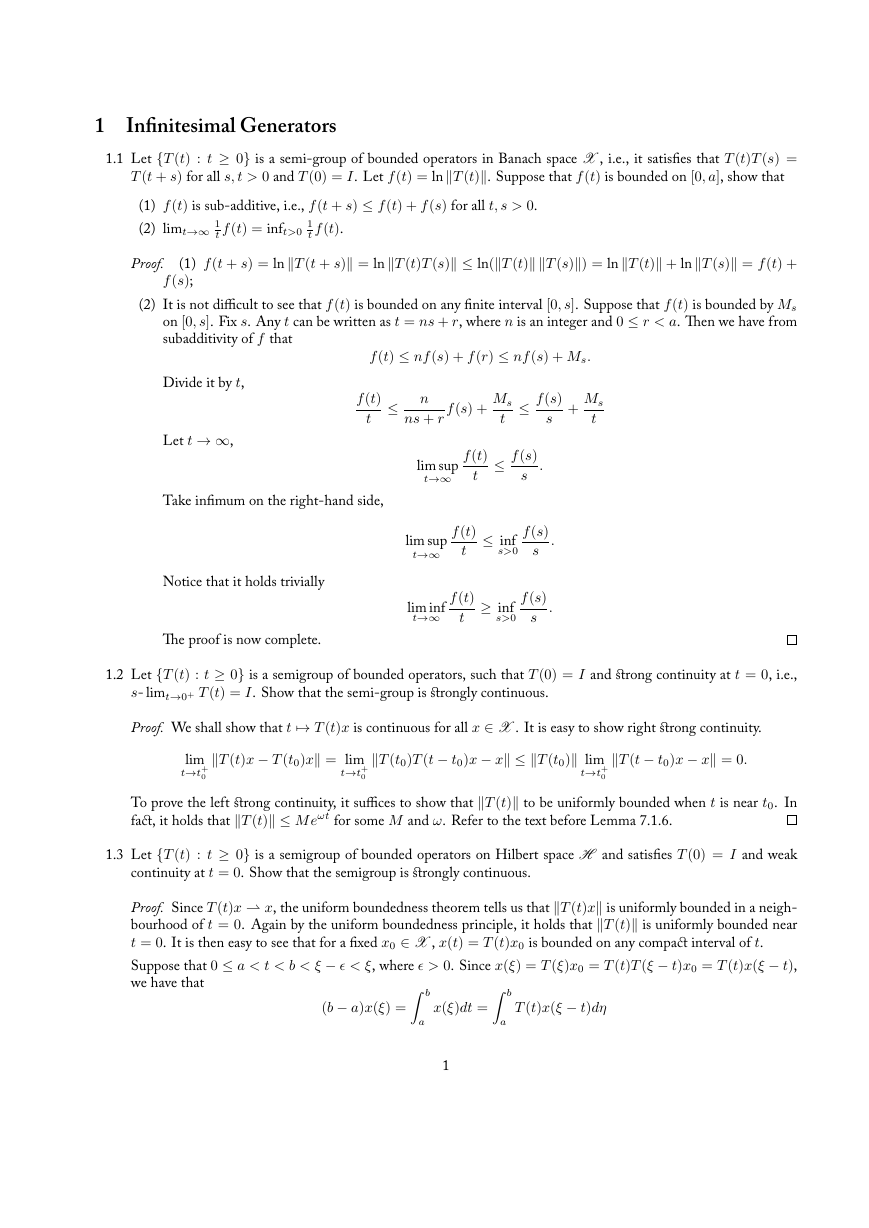
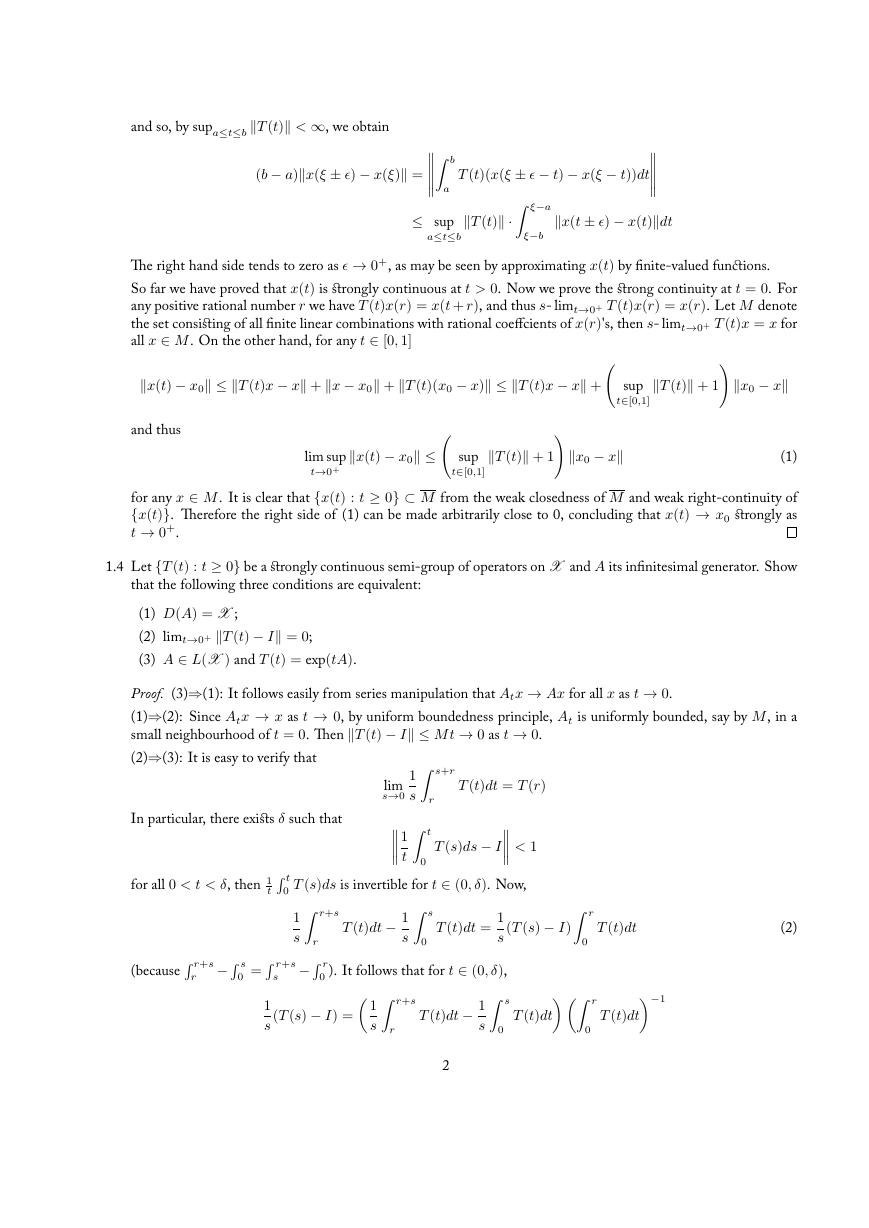

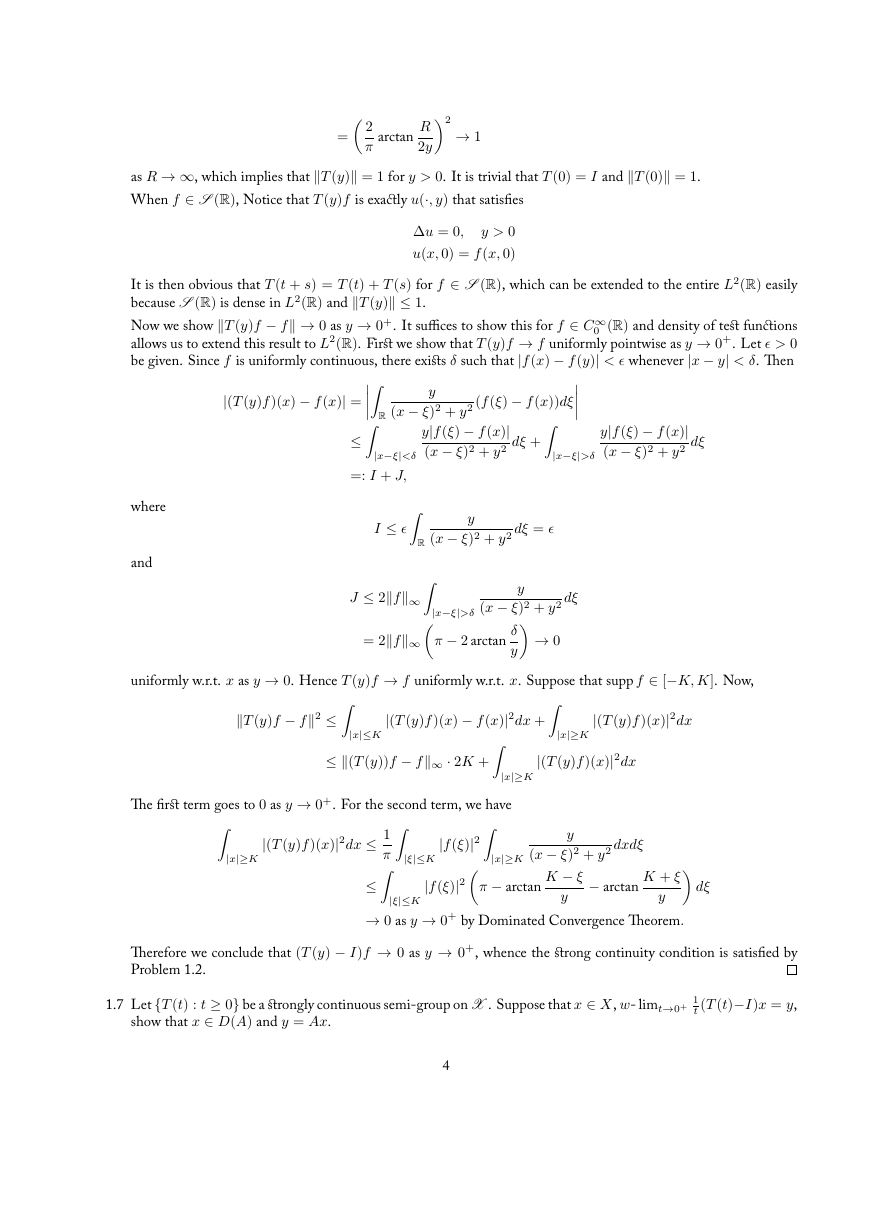

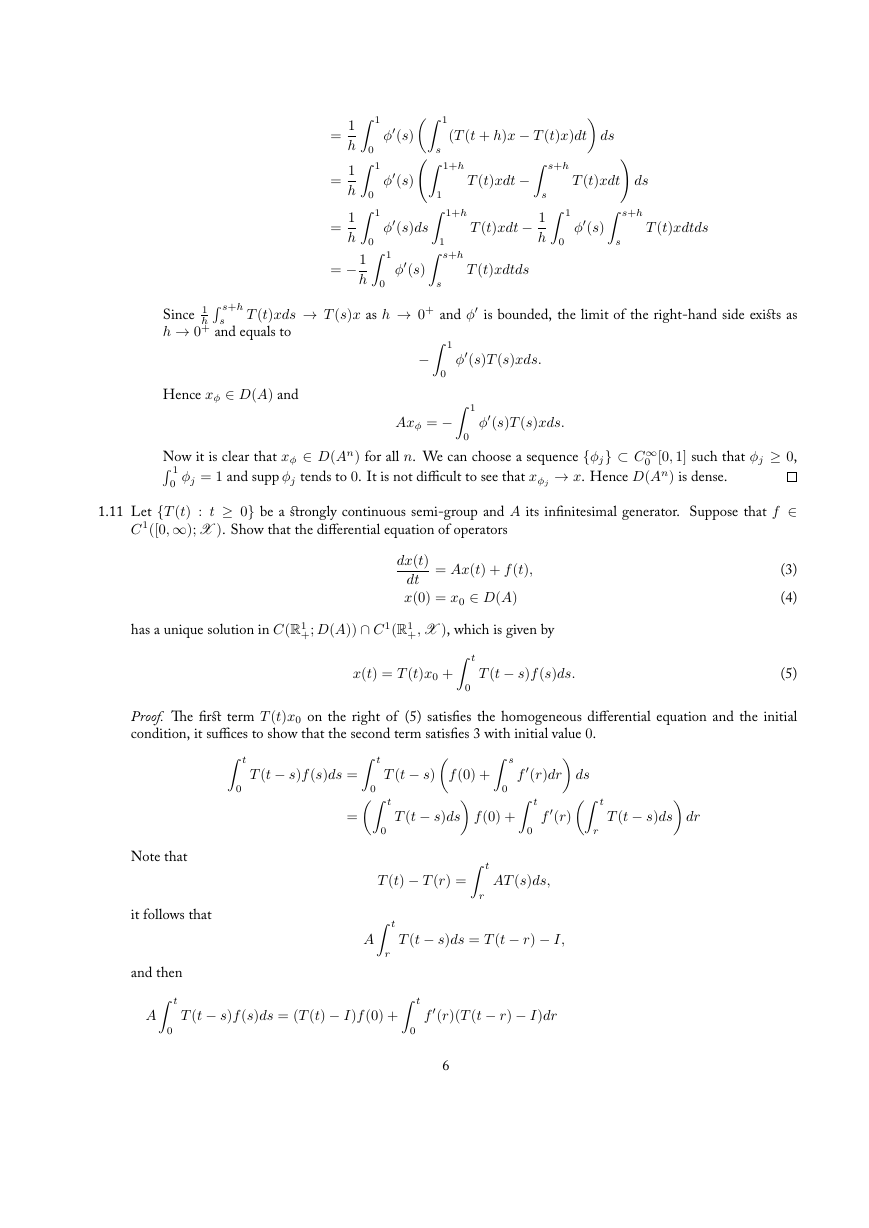
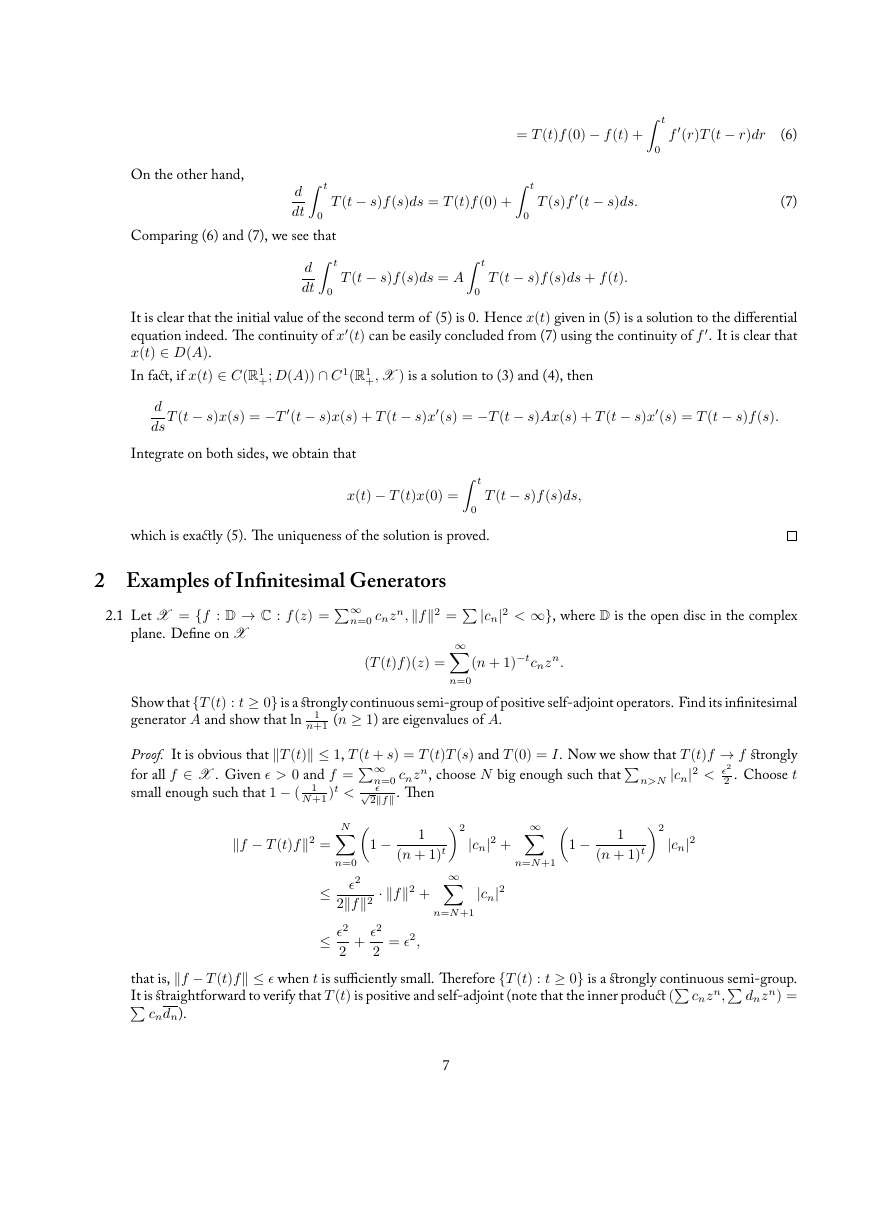
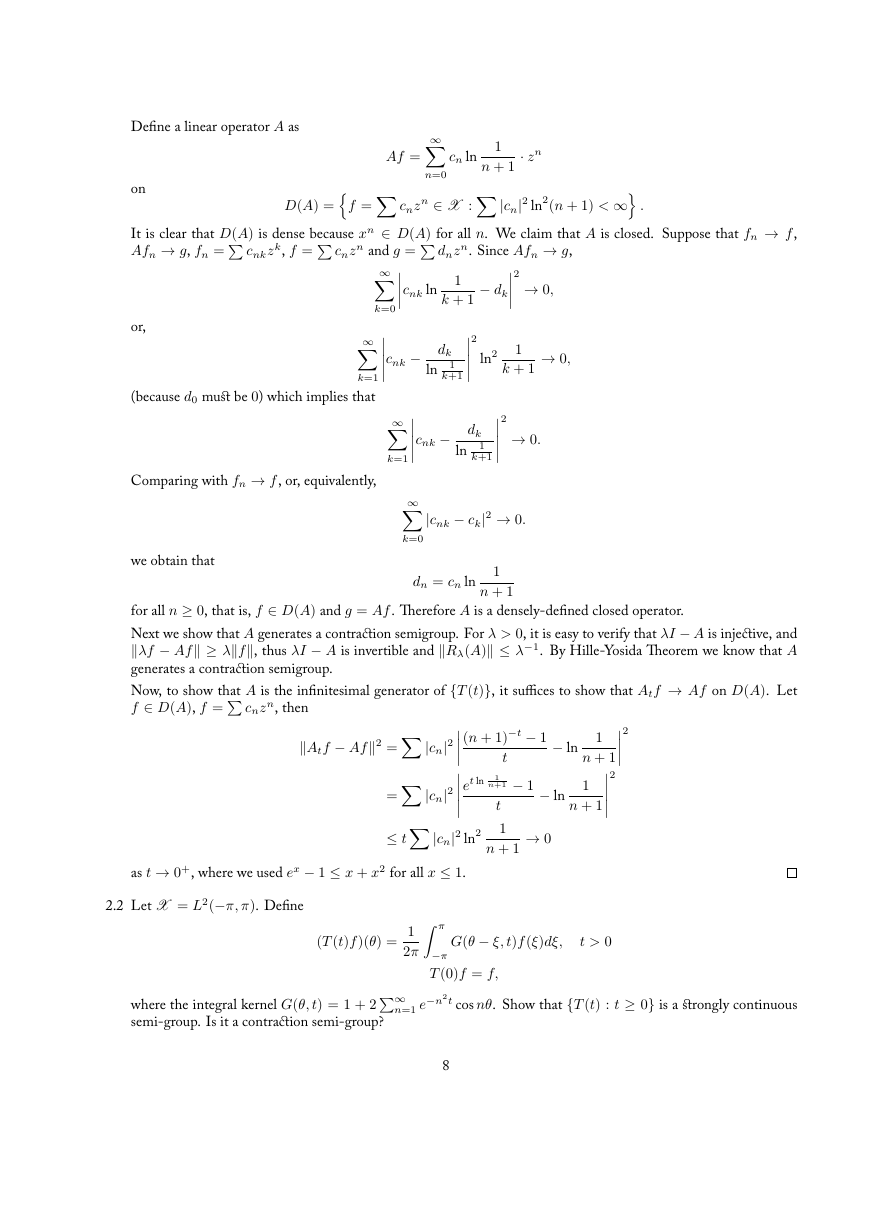








 2023年江西萍乡中考道德与法治真题及答案.doc
2023年江西萍乡中考道德与法治真题及答案.doc 2012年重庆南川中考生物真题及答案.doc
2012年重庆南川中考生物真题及答案.doc 2013年江西师范大学地理学综合及文艺理论基础考研真题.doc
2013年江西师范大学地理学综合及文艺理论基础考研真题.doc 2020年四川甘孜小升初语文真题及答案I卷.doc
2020年四川甘孜小升初语文真题及答案I卷.doc 2020年注册岩土工程师专业基础考试真题及答案.doc
2020年注册岩土工程师专业基础考试真题及答案.doc 2023-2024学年福建省厦门市九年级上学期数学月考试题及答案.doc
2023-2024学年福建省厦门市九年级上学期数学月考试题及答案.doc 2021-2022学年辽宁省沈阳市大东区九年级上学期语文期末试题及答案.doc
2021-2022学年辽宁省沈阳市大东区九年级上学期语文期末试题及答案.doc 2022-2023学年北京东城区初三第一学期物理期末试卷及答案.doc
2022-2023学年北京东城区初三第一学期物理期末试卷及答案.doc 2018上半年江西教师资格初中地理学科知识与教学能力真题及答案.doc
2018上半年江西教师资格初中地理学科知识与教学能力真题及答案.doc 2012年河北国家公务员申论考试真题及答案-省级.doc
2012年河北国家公务员申论考试真题及答案-省级.doc 2020-2021学年江苏省扬州市江都区邵樊片九年级上学期数学第一次质量检测试题及答案.doc
2020-2021学年江苏省扬州市江都区邵樊片九年级上学期数学第一次质量检测试题及答案.doc 2022下半年黑龙江教师资格证中学综合素质真题及答案.doc
2022下半年黑龙江教师资格证中学综合素质真题及答案.doc